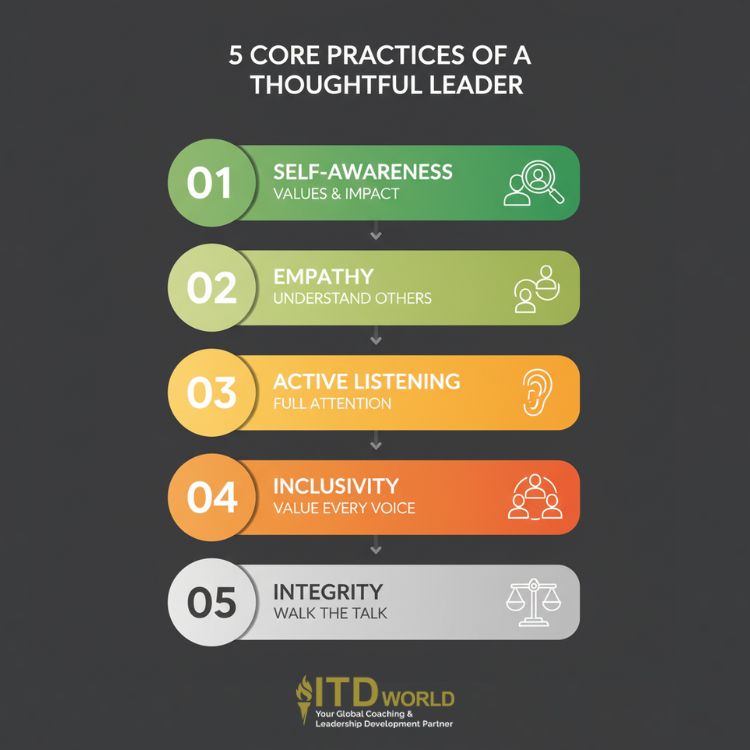Discover the proven benefits of thoughtful leadership, plus how to practice this style and make it a corporate norm.
While speed is often celebrated in business, sustainable success requires a mature management approach – one that prioritizes careful consideration, inclusive decision-making, and a genuine understanding of one’s impact on their people. By moving beyond short-term, reactive wins to embrace a thoughtful leadership style, leaders build the essential foundation for lasting, positive results and deep organizational trust.
|
Author: Jonathan M. Pham |
Highlights
- Thoughtful leadership is a management approach that prioritizes careful consideration, empathy, and a long-term perspective to foster positive relationships and achieve sustainable impact. A powerful driver of business success, it is key to ensuring more informed decisions, building a high-performance culture, and increasing employee engagement and retention.
- Thoughtful leaders practice self-awareness, empathy, active listening, and inclusivity, while also leading with integrity to build trust and foster an environment where everyone feels valued and understood.
- To be a thoughtful leader, one should incorporate pause points into their routine, adopt a questioning mindset, and intentionally seek out diverse perspectives to challenge their own thinking.
- To foster a thoughtful culture, organizations must redesign processes to allow for consideration, promote those who embody thoughtfulness, and invest in training that cultivates self-awareness, active listening, and empathy.
- While the pressure for speed, the risk of analysis paralysis, and emotional fatigue pose significant challenges, aspiring thoughtful leaders can overcome them by managing expectations, setting clear time constraints, and practicing self-compassion.
What is Thoughtful Leadership?
Thoughtful leadership is a management approach that emphasizes careful consideration, empathy, and a long-term perspective in all decisions and actions. It moves beyond simply exerting authority and focuses instead on fostering positive relationships, promoting collaboration, and generating meaningful, sustainable impact.
The core of this practice is the intentional pause – the moment a leader takes between a stimulus and their response to consider the best course of action. It is the crucial difference between a knee-jerk reaction and a considered response. For example, think about someone who receives a surprising and disappointing quarterly sales report.
- A reactive leader is likely to immediately call an emergency meeting, express their frustration, and demand an explanation for the poor numbers, thereby creating a climate of fear and defensiveness.
- A thoughtful one, on the other hand, would take the time to analyze the data, consider potential external market factors, and reflect on the team’s efforts. They would then schedule a meeting not to assign blame, but to ask curious questions – e.g. “This report was not what we expected. Let’s walk through the data together to understand what happened. What are the key lessons we can learn from this quarter that will make us stronger in the next?”

What does it mean to be a thoughtful leader
Why is Thoughtfulness Important in Leadership?
The practice of thoughtful leadership, while focused on seemingly “soft” skills like consideration and empathy, is in fact a powerful driver of hard business results. In a world defined by complexity and rapid change, the intentional pause and deep consideration that lies at the heart of this approach is key to securing a sustainable competitive advantage.
- More well-informed decisions
A hallmark of thoughtful leaders is inclusivity; specifically, they are willing to pause, listen, and consider diverse perspectives instead of prioritizing speed above all else. This mindset – coupled with their tendency to think about long-term consequences – enables them to come up with better business decisions and avoid costly mistakes in the long run.
When leaders demonstrate that they are genuinely listening and taking into account their team’s input, it creates an environment of trust and psychological safety – where employees feel safe to speak up, share ideas, and take smart risks. Such a positive team climate has been revealed to be a primary driver of performance and innovation.
- Enhanced engagement & retention
People are far more likely to be motivated and loyal when they feel their management genuinely values their well-being and respects their perspective. A thoughtful leader’s approach directly addresses the core human need to feel heard and appreciated. This is critical in the modern talent market, where studies have shown that a supportive and respectful management style is one of the top drivers of employee satisfaction – and a key factor in reducing costly turnover.
The 5 Core Practices of a Thoughtful Leader
-
Cultivate self-awareness
Internal clarity is the prerequisite for all other thoughtful actions. As a result, one needs to adopt the practice of regularly looking inward to get in touch with their own values, strengths, weaknesses, biases, and emotional triggers – as well as to reflect on their impact on others.
Example: Before entering a high-stakes meeting, a leader should take a moment to acknowledge their own assumptions or anxieties, so that they may approach the situation with greater objectivity and intention.
-
Develop genuine empathy
True empathy requires one to move beyond their own perspective to consider the experiences, feelings, and motivations of others. Such quality is the engine of connection and trust.
Example: When a team member is struggling with their workload, a thoughtful leader’s first instinct isn’t to focus on the missed deadline or final output. Instead, they seek to know the person’s context by saying something like, “What are the biggest pressures you’re facing right now?”
-
Engage in active listening
Thoughtfulness in conversations means that one needs to give their full, non-judgmental attention as the other person is speaking. Only by resisting the urge to formulate a response may one better understand people’s perspectives and therefore come up with more informed decisions (as well as win the respect of others).
Example: In a team meeting, a thoughtful leader ensures all voices are heard. Aside from listening intently, they also summarize key points to confirm their understanding (e.g., “So, if I’m hearing you correctly, the main concern is…”), and ask clarifying questions.
-
Foster inclusivity
As mentioned, one crucial part of inclusivity is the commitment to building up an environment where every team member, regardless of their background, role, or viewpoint, feels safe and empowered to contribute their unique perspective. For this purpose, leaders are expected to actively seek out dissenting opinions. During a decision-making process, it is recommended that they specifically ask the quietest person in the room for their thoughts – or create anonymous feedback channels to ensure that even unpopular ideas can be freely shared and considered.
Read more: Soliciting Feedback – Key to a Building a Better Workplace
-
Lead with integrity
The ability to “walk the talk” or “practice what one preaches” is the cornerstone of thoughtful leadership. By aligning their actions with high ethical standards and stated values, one lays the foundation for establishing long-term credibility and trust.
Example: If a leader espouses a value of “transparency,” they should demonstrate it by being honest about challenges and sharing information openly, even when it’s difficult. When their actions consistently match their words, their integrity becomes a reliable anchor for the entire team.
Read more: Leading by Example – Key to Truly Inspiring Action

How to Be a Thoughtful Leader: Strategies & Best Practices
Thoughtful leadership begins internally. It is a direct result of the inner disciplines one practices consistently to manage their own reactions and broaden their perspective.
-
Incorporate “pause points” into your routine
The very foundation of thoughtfulness is the ability to resist the urge for immediate reaction – which is achieved by intentionally creating moments of pause throughout a busy day, so as to build the muscle of self-awareness.
Formally, it means scheduling 15 minutes (or so) of self-reflection on your calendar at the end of each day to review your interactions.
Informally, it means practicing mindfulness in the moment.
Example: Before entering a difficult conversation or responding to a stressful email, take just three conscious breaths. As simple as it may seem, this intentional pause creates the mental space needed for a considered response rather than a knee-jerk reaction.
-
Adopt a questioning mindset
A thoughtful leader is defined less by the quality of their answers and more by the quality of their questions. In other words, they shift from a default mindset of “knowing” to one of “learning and discovering.”
How-to: Before making a key decision, train yourself to ask a series of thoughtful questions that go beyond the surface level. Instead of just “What should we do?”, try to make your inquiry more specific – for example:
- Perspective question: “Whose perspective have we not yet heard from?”
- Consequence question: “What are the likely second- and third-order consequences of this decision?”
- Values question: “Which option is most aligned with our team’s core values?”
Read more: Leadership Philosophy – How to Define Your True North & Follow It
-
Intentionally seek out diverse perspectives
Thoughtfulness requires being exposed to ideas and viewpoints that challenge one’s own. A leader must actively fight the comfort and blind spots of their own echo chamber – by making it a habit to consume information from a wide variety of sources outside their usual preferences. If possible, it is recommended that they read books or listen to podcasts from authors and thinkers outside of their industry too.
Example: In a team meeting, don’t just pay attention to the people you already agree with. Rather, do your best to encourage the dissenting opinion by saying, “That’s a very popular idea, but I want to make sure we’re seeing all the angles. Sarah, I know you sometimes have a different take on these things. What potential risks or downsides do you see?”
Promoting a Thoughtful Culture in the Workplace
- “Slow down to speed up”
Many organizational processes are implicitly designed to reward speed above all else, which can inadvertently punish thoughtfulness. As such, companies should intentionally incorporate space for consideration into its most critical workflows.
Example: When making a major strategic decision, instead of demanding an immediate answer in a single meeting, the process could be redesigned to include a pre-reading period for all stakeholders and a “silent start” to the meeting where everyone has five minutes to write down their own ideas before the open discussion begins.
- Reward thoughtful individuals
The most powerful message an organization sends about its values is reflected in who it chooses to promote. To establish a thoughtful culture, you must elevate those who actively embody this quality – rather than just looking at the loudest or fastest decision-makers.
Example: During your talent review sessions, try asking questions that assess thoughtfulness: “How does this leader gather diverse perspectives before acting?” or “Can you provide an example of how this leader considered the long-term impact of a decision, not just the short-term win?”
- Invest in cultivating thoughtful capabilities
The core competencies that enable thoughtful leadership – self-awareness, active listening, empathy – are not always innate. As such, organizations have a responsibility to provide the training to build these skills at scale – whether through formal learning workshops or one-on-one coaching sessions.
Read more: Organizational Culture – The Invisible Force Behind Success

Thoughtful leadership in the workplace
Challenges of Thoughtful Leadership
- The pressure for speed
In today’s fast-paced environment, a leader who takes time to pause, listen, and consider is likely to be perceived by others as being slow, indecisive, or a bottleneck to progress. The key to overcoming this perception is to manage expectations by making your thoughtful process visible.
Example: Instead of simply delaying a decision, one should communicate their intention to the team, “This is an important decision, and I want to ensure we get it right. I’m going to take the next 24 hours to review the data and gather input from the key stakeholders, and I will have a final decision for you by 10 AM tomorrow.”
- The risk of “analysis paralysis”
The desire to gather all possible information/ perspectives may sometimes cause one to become stuck in a cycle of analysis, making it difficult to ever make a final call. In that case, it is crucial to balance consideration with commitment by using time constraints
In practice: Use the technique of time-boxing. For instance, “We will spend the next 45 minutes brainstorming all possible options for this problem. At the end of that time, we will select the top two for further analysis and make a final choice by the end of the day.” By setting a clear deadline for the consideration phase, the leader ensures that thoughtfulness leads to a decision, not just an endless discussion.
- Emotional fatigue
The act of genuinely listening to and considering the ideas/ feelings of every team member, especially during times of high stress or conflict, involves significant emotional labor. This can be incredibly draining and, if not managed, is likely to give rise to leadership burnout.
Fortunately, the problem can be offset by practicing self-compassion, having “recharge” rituals (e.g. mindfulness or debriefing with a trusted coach), and setting healthy boundaries. For example, one may be empathetic to an employee’s frustration while still maintaining a professional focus, saying, “I understand your frustration. Now, let’s focus our energy on what we can control and find a constructive path forward together.”
Read more: Compassionate Leadership – Beyond Simply ‘Being Nice’
Sample Thoughtful Leadership Questions
Reflecting inward (on self-awareness & integrity)
- Did my actions and decisions this week align with my core values and the leader I aspire to be?
- What is one thing I learned this week (from a success or a mistake) that might change my perspective?
- When did I feel most energized and engaged this week, and when did I feel most drained? What does that pattern tell me?
Reflecting outward (on team & empathy)
- Whose perspective have I not yet heard or fully considered on our most important challenge?
- Did I create an environment this week where my team members felt psychologically safe to speak up, ask questions, and be honest?
- In what ways did I truly empower my team, and in what ways might I have unintentionally been a bottleneck to their progress?
Reflecting forward (on strategy & vision)
- What are the potential long-term consequences (positive or negative) of the most significant decision I made this week?
- How did I help my team connect their daily work to our organization’s larger purpose?
- What is the single most important obstacle I can remove for my team next week?
- Am I and my team focused on solving the most important problem, or just the most urgent one?
Thoughtful Leadership Quotes
Check out more quotes about mindfulness here!
Leadership is not about titles, positions, or flowcharts. It is about one life influencing another.
Becoming a leader is synonymous with becoming yourself. It is precisely that simple and it is also that difficult.
Warren G. Bennis
Thought leadership is not about being unique or smart or clever but about being uniquely valuable.
Michael Brenner
True thought leaders inspire change in others and actively make changes themselves because they are actively in front of their cause.
Dillon Kivo
You don’t lead by pointing and telling people some place to go. You lead by going to that place and making a case.
Ken Kesey
Don’t be intimidated by what you don’t know. That can be your greatest strength.
Sara Blakely
Do not follow where the path may lead. Go instead where there is no path and leave a trail.
Ralph Waldo Emerson
The very essence of leadership is that you have to have vision. You can’t blow an uncertain trumpet.
Theodore M. Hesburgh

Thoughtful Leadership Books
- 📘 Thoughtful Leadership by Fiona Buckland
A practical and soulful guide to authentic leadership – in which the author integrates emotional intelligence, mindfulness, and purpose-driven action to enable leaders to align their inner values with outer impact. It’s like having a personal coach walk one through self-awareness, self-regulation, and conscious decision-making.
- 📗 The Thoughtful Leader Jim Fisher
Fisher presents a compelling framework that blends seemingly opposing leadership styles – managing, directing, and engaging – into one coherent model. Designed for those working in fast-changing environments, his work emphasizes integrity, adaptability, and the ability to lead with both structure and empathy.
The book breaks down leadership into 12 actionable disciplines such as clarity, character, competence, caring, and courage. The authors argue that great leaders are made, not born – and they provide a roadmap for adopting habits of excellence through focused, incremental growth.
- 📕 5 Levels of Mastery by Dr. Peter Chee & Dr. Marshall Goldsmith
A transformational guide that combines coaching, mentoring, and personal development, the book introduces five levels of self-mastery and ten disciplines for living a fulfilling life. It’s packed with tools, reflective questions, and real-world applications for leaders to better unlock their potential and multiply their impact.
Become a Thoughtful Leader with ITD World
Cultivating the discipline of thoughtful leadership is a journey that transforms not just a leader’s impact, but also their inner experience of the role. This path of developing deep self-awareness, empathy, and strategic foresight is one of the most meaningful investments one may make in themselves and the organization.
At ITD World, we specialize in enabling leaders to cultivate the sophisticated, human-centric capabilities required to lead effectively in today’s complex world. Our programs are designed to move beyond theory and provide the practical tools and supportive environment needed to foster a more thoughtful and intentional management approach.
- Executive coaching: ITD World’s one-on-one coaching provides a confidential space for participant to acquire deep self-awareness, practice reflection, and refine their decision-making process with an expert thought partner.
- Leadership workshops: We offer targeted training programs focused on the core skills of a thoughtful leader, including Emotional Intelligence, Active Listening, Strategic Thinking, and more!
- Customized in-house solutions: We partner with organizations to design bespoke programs that help your entire management team promote a more inclusive and high-trust culture.
Ready to lead with greater intention, wisdom, and impact? Contact ITD World today to explore how you may benefit from our wide array of solutions!
Other resources you might be interested in:
- Leadership Culture: The DNA of Organizational Success
- Humble Leadership: The Quiet, Often Forgotten Powerhouse
- Building a Lasting Leadership Legacy: How to Move Beyond the Title

